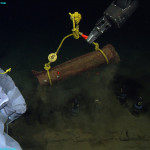Science costs money. No matter how clever we are – and trust me, as a graduate student, I have made scientific equipment by combining salvaged parts, scrap lumber from Home Depot, and rubber tie-downs – there’s no getting around the need for supplies or travel or ship time. Traditional funding, such as grants from federal or state government, is becoming increasingly difficult to obtain. On the other hand, our compadres in the arts are increasingly turning to crowdfunding – getting small amounts of money from many people in order to create a specific project.
Can crowdfunding work in science? Signs point to yes. In my little corner of the ocean-verse, marine debris,, there have been a couple examples of successful crowdfunded projects. Most famously, journalist Lindsay Hoshaw crowdfunded her trip to the North Pacific Subtropical Gyre (though it should be noted that as a scientist, I was less than impressed with the resultant New York Times article), and my colleague Chelsea Rochman raised travel money for her trip to the South Atlantic Subtropical Gyre.
But just being a little project adrift in the endless internet sea can be hard, especially for scientists who are not already involved in online communication. Enter the #SciFund project, organized by ecologists/webnerds Dr. Jai Ranganathan and Dr. Jarrett Byrnes. In their Call To Arms they write:
The current rate of funding for science proposals in the U.S. is ~20%. The current rate for funding statues of RoboCop in Detroit is 135% – to the tune of $67,436.
All of the traditional sources of cash for science – the National Science Foundation, the National Institutes of Health, NASA, private foundations – are getting harder and harder to access. And the situation is probably only going to get worse. So what is a scientist to do? How can our funding be as secure as RoboCop’s?…..
We’d like to propose an experiment to fund our science in an entirely new way – the #SciFund Challenge.
Intrigued? You should be – DSN’s own Blog Poppa, Dr. M, will be participating, so you KNOW it’s going to be off the hook. Check out more details on how #SciFund works and sign up here.






http://alistairdove.com/blog/2010/8/30/whale-shark-genome-schwag-has-been-unbridled.html is my answer to the question you pose; a very emphatic yes! Our silly band program has been successful beyond our expectations.
I think small, time-limited projects could be crowd funded.
But long-term projects and long-term monitoring and data collection are costly and require large-scale networks with consistent data collection standards. They require investments in infrastructure. These funding needs aren’t sexy, which is why they have a hard time getting funded to begin with. Also, short funding cycles emphasize short turn-around periods for results; that works for some types of research, but not all.
Plus, I think it’s important to always argue for public funding of science: public funding of science in the public interest that results in public data. Private funding too easily leads to proprietary data and information.
I agree with @cbdawson — I don’t want to sound like I’m poo-poohing the crowd-funding idea, I think it might work for some types of projects. But, it would be a shame if the excitement around the concept and anecdotes of success of crowd-funding led to continued erosion of ‘traditional’ funding because the powers-that-be decide science can find money elsewhere. After a couple years of crowd-funded science I’d want to see a quantitative breakdown of the numbers — how much $$ and where did it go.
Oh, I agree that there’s no way that crowdfunding can or should fund all science. But I think it can play an important role, and is also a way for the public to feel invested in the scientific process. Come to think of it, Earthwatch is an interesting example of a type of science crowdfunding, and that’s been going on for a couple decades at least.
@cbdawson, I think that long-term projects are not well served by traditional funding either – it’s notoriously difficult to get NSF funding for long-term studies monitoring programs, despite their importance. This is not unique to science – everyone thinks it’s more fun to build something new to maintain existing non-new structures or programs. Agree re: public data – though we also have a way to go on that with traditional federal funding, particularly on the publication side.
Brian – I think that crowdfunding and traditional funding are quite complementary. Most people still think of scientists as Einsteins – white haired old men doing completely obscure weird math things that normal people can’t understand – when in fact so much science is done in cool places by non-Einstein-looking people doing relatively easily understandable things. If someone is participating in crowdfunding science, they are more likely to feel invested in the scientific process and less likely to listen to politicians who think that fruit fly research is a waste of time. I agree that an accounting process is important, especially if the idea is that larger and larger projects would be crowdfunded.
I love this post. We firmly believe that science can be assisted by Crowd Funding. Crowd Funding may not take the place of NSF grants, but it can definitely fill in some holes in science budgets that are being hurt by restricted government science spending. This is why we created FundaGeek.com to address the needs of technical innovation and basic research.
I know I am late to see this, but I am so busy in the fall, I rarely get to surf the interwebs to find great posts like this. Great post Miriam! MDT funding from NOAA runs out next year and I think the public would love to see it continue. This might be a way to make it happen (without having to put ads on the app or charge for it). I also was looking for a “like” button for your comment above! :)